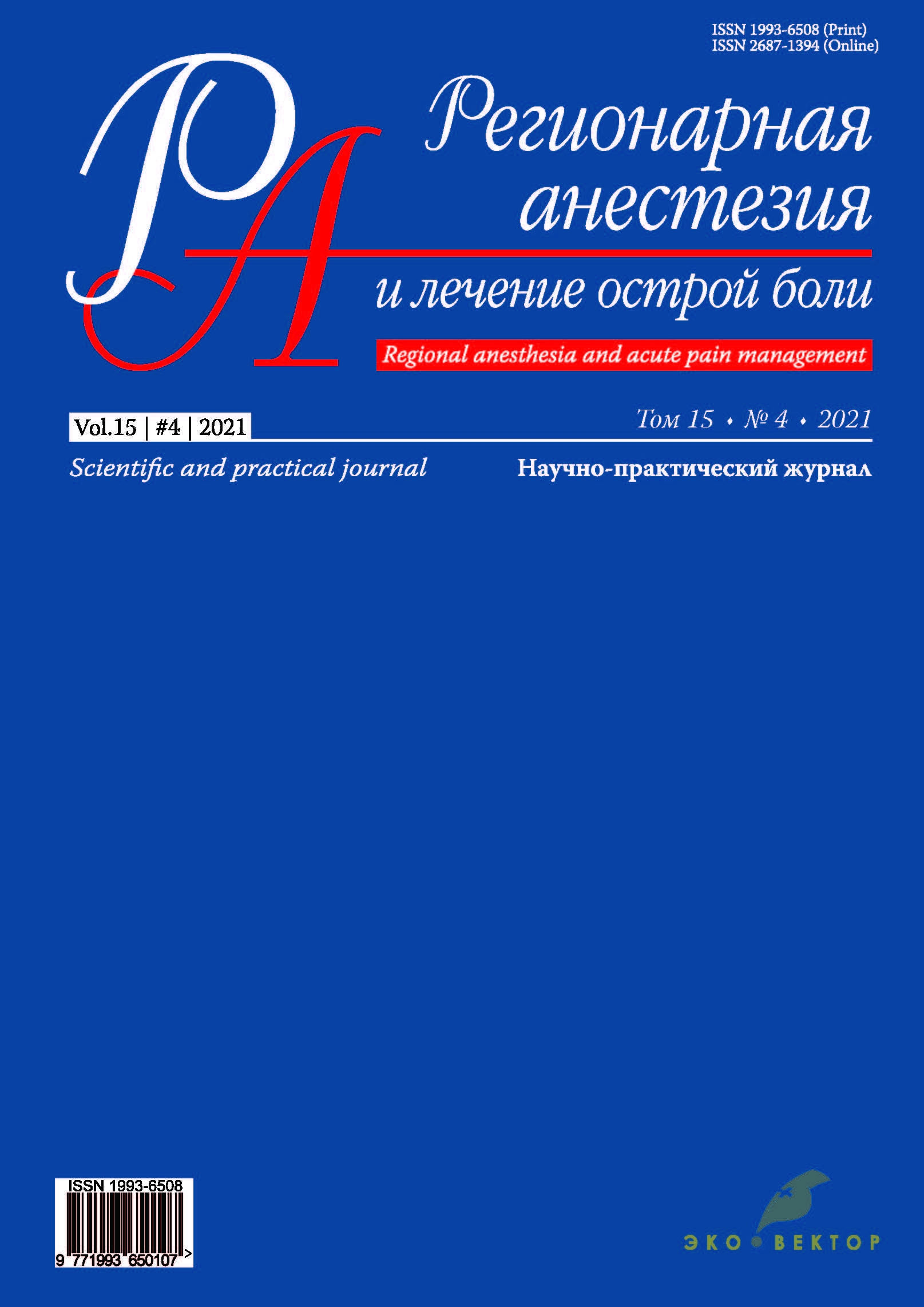Comparative evaluation of the use of femoral nerve block and adductor canal as a component of early patient activation after knee arthroplasty
- 作者: Krylov S.V.1,2, Pasechnik I.N.2
-
隶属关系:
- National Medical Research Center of Traumatology and Orthopedics named after N.N. Priorova
- Central State Medical Academy of the Administrative Department of the President of the Russian Federation
- 期: 卷 15, 编号 4 (2021)
- 页面: 257-265
- 栏目: Original study articles
- ##submission.dateSubmitted##: 17.05.2022
- ##submission.datePublished##: 15.09.2021
- URL: https://rjraap.com/1993-6508/article/view/107978
- DOI: https://doi.org/10.17816/RA107978
- ID: 107978
如何引用文章
详细
BACKGROUND: The number of surgical interventions for the knee joint increases annually due the increase in the total number of patients and the improvement of operation techniques. The provision of modern anesthesiology and intensive care is associated with a positive treatment outcome, which is based on adequate pain relief in the perioperative period, suppressed complications, and reduction in hospital stay. Regional analgesia is a modern and effective method of pain relief after knee surgery. However, the location of peripheral blockade may affect the timing of activation and rehabilitation in these patients.
AIM: This study aimed to evaluate the use of femoral nerve and adductor canal blockade in the framework of the accelerated recovery program after knee arthroplasty.
MATERIALS AND METHODS: A prospective, randomized, single-center study included 80 patients who underwent primary knee arthroplasty and were randomly assigned to two clinical groups. Group 1 (n=40) included patients who underwent femoral nerve blockade in the postoperative period, and group 2 (n=40) included patients who underwent adductor canal blockade in the postoperative period. In the postoperative period, the level of pain at rest and during movement was analyzed using a visual analog pain level scale after 6, 12, 24, and 48 hours. The amount of prescribed narcotic analgesic in the postoperative period was recorded, and the total distance that patients were able to walk after 6, 12, 24, and 48 hours was measured.
RESULTS: For the level of pain at rest and during movement, no significant differences at all time intervals were observed for both groups (p >0.05). No additional prescription of narcotic analgesics was required. Compared with group 1, group 2 covered a significantly greater distance in the first 24 after the operation. After 48 hours, no significant differences were found between the two groups (p >0.05).
CONCLUSIONS: Femoral nerve and adductor canal blockades provide an adequate level of analgesia after knee arthroplasty. In particular, adductor canal blockade significantly increase the distance of movement by patients in the first 24 hours after surgery.
全文:
作者简介
Sergey Krylov
National Medical Research Center of Traumatology and Orthopedics named after N.N. Priorova; Central State Medical Academy of the Administrative Department of the President of the Russian Federation
编辑信件的主要联系方式.
Email: doc087@inbox.ru
ORCID iD: 0000-0001-7755-7163
SPIN 代码: 4067-1787
MD, Cand. Sci. (Med.)
俄罗斯联邦, Moscow; MoscowIgor Pasechnik
Central State Medical Academy of the Administrative Department of the President of the Russian Federation
Email: pasigor@yandex.ru
ORCID iD: 0000-0002-8121-4160
SPIN 代码: 4433-1418
MD, Dr. Sci. (Med.), Professor
俄罗斯联邦, Moscow参考
- Ovechkin AM. Postoperative pain: the state of problem and current trends in postoperative analgesia. Regional anesthesia and acute pain management. 2015;9(2):29–39. (In Russ).
- Ovechkin AM. Chronic postoperative pain syndrome – «a pitfall» of modern surgery. Regional Anesthesia and Acute Pain Management. 2016;10(1):5–18. (In Russ). doi: 10.18821/19936508-2016-10-1-5-18
- Pasechnik IN, Skobelev EI, Lipin IE. Fast-Track program in surgery: the role of postoperative anesthesia. Doctor.Ru. 2015;(15):49–53. (In Russ).
- Jaeger P, Zaric D, Fomsgaard JS, et al. Adductor canal block versus femoral nerve block for analgesia after total knee arthroplasty: a randomized, double-blind study. Reg Anesth Pain Med. 2013;38(6):526–532. doi: 10.1097/AAP.0000000000000015
- Davis JJ, Bond TS, Swenson JD. Adductor canal block: more than just the saphenous nerve? Reg Anesth Pain Med. 2009;34(6):618–619. doi: 10.1097/AAP.0b013e3181bfbf00
- van der Wal M, Lang SA, Yip RW. Transsartorial approach for saphenous nerve block. Can J Anaesth. 1993;40(6):542–546. doi: 10.1007/BF03009739
- Kim DH, Lin Y, Goytizolo EA, et al. Adductor canal block versus femoral nerve block for total knee arthroplasty: a prospective, randomized, controlled trial. Anesthesiology. 2014;120(3):540–550. doi: 10.1097/ALN.0000000000000119
- Kwofie MK, Shastri UD, Gadsden JC, et al. The effects of ultrasound-guided adductor canal block versus femoral nerve block on quadriceps strength and fall risk: a blinded, randomized trial of volunteers. Reg Anesth Pain Med. 2013;38(4):321–325. doi: 10.1097/AAP.0b013e318295df80
- Labraca NS, Castro-Sanchez AM, Mataran-Penarrocha GA, et al. Benefits of starting rehabilitation within 24 hours of primary total knee arthroplasty: randomized clinical trial. Clin Rehabil. 2011;25(6):557–566. doi: 10.1177/0269215510393759
- Chandrasekaran S, Ariaretnam SK, Tsung J, Dickison D. Early mobilization after total knee replacement reduces the incidence of deep venous thrombosis. ANZ J Surg. 2009;79(7–8):526–529. doi: 10.1111/j.1445-2197.2009.04982.x
- Mudumbai SC, Kim TE, Howard SK, et al. Continuous adductor canal blocks are superior to continuous femoral nerve blocks in promoting early ambulation after TKA. Clin Orthop Relat Res. 2014;472(5):1377–1383. doi: 10.1007/s11999-013-3197-y
- Shah NA, Jain NP. Is continuous adductor canal block better than continuous femoral nerve block after total knee arthroplasty? Effect on ambulation ability, early functional recovery and pain control: a randomized controlled trial. J Arthroplasty. 2014;29(11):2224–2229. doi: 10.1016/j.arth.2014.06.010
- Seo SS, Kim OG, Seo JH, et al. Comparison of the Effect of Continuous Femoral Nerve Block and Adductor Canal Block after Primary Total Knee Arthroplasty. Clin Orthop Surg. 2017;9(3):303–309. doi: 10.4055/cios.2017.9.3.303
- Li D, Ma GG. Analgesic efficacy and quadriceps strength of adductor canal block versus femoral nerve block following total knee arthroplasty. Knee Surg Sports Traumatol Arthrosc. 2016;24(8):2614–2619. doi: 10.1007/s00167-015-3874-3
补充文件











